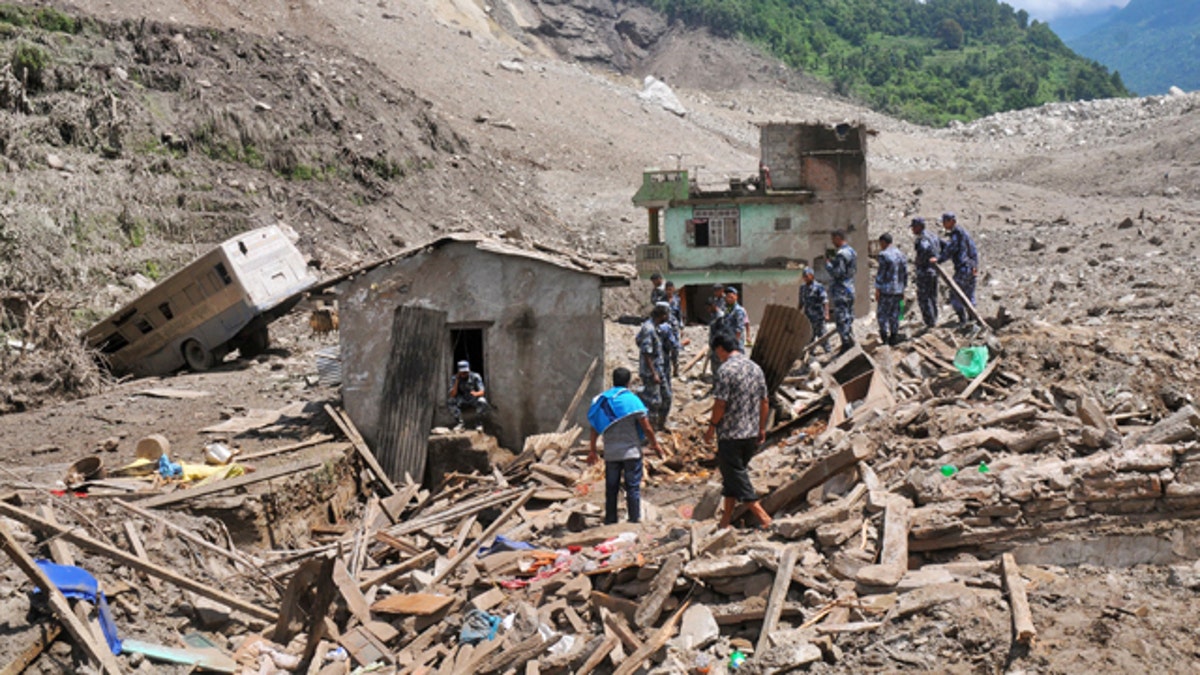
August 2, 2014: Nepalese security personnel gather for rescue work at the site of a landslide in Sindhupalchowk area, about 75 miles east of Katmandu. A massive landslide killed at least eight people and blocked a mountain river in northern Nepal on Saturday, causing the water to form a lake that was threatening to burst and sweep several villages, officials said. (AP Photo/Dinesh Gole)
KATMANDU – There is no chance of finding any of the more than 150 people who are believed to have been buried by a massive landslide in northern Nepal, an official said Sunday, as rescuers struggled to dig through piles of rock, mud and trees.
Rescuers have so far recovered only eight bodies since the landslide early Saturday blocked a mountain river, causing the water to form a lake that was threatening to burst and sweep several villages. Fresh rainfall on Sunday hampered search attempts.
"We have no chance of finding any of the missing people alive under this pile of debris," said Yadav Prasad Koirala, who heads the government's Department of Natural Disaster Management. "We have names of 159 people who are believed to be missing and buried, but there could be even more people."
Koirala said it was even difficult for bulldozers and heavy equipment to move the debris that crushed dozens of houses in the village of Mankha, about 75 miles east of Katmandu, Nepal's capital.
Gopal Parajuli, the chief government administrator in the area, said the water level and mud was making the rescue work very difficult, and that army troops used explosives to try to alleviate a dangerous buildup of water.
The controlled explosions managed to knock down part of an earth wall that had blocked a river and created a temporary dam, allowing some water to flow out, but much of it still remained trapped, posing an immediate threat to downstream villages as far away as India, Parajuli said.
He said the amount of water flowing out of the dam and pouring in was almost the same Sunday morning as the previous day, keeping the water level stable.
A Mankha resident who was among the dozens of people injured by the landslide said he feared his entire village had been wiped out.
"There are nearly 100 people in the 60 houses in my village and 20 more people in the neighboring village who were buried by the landslide. All of them are likely dead," Durga Lal Shrestha said Saturday from his hospital bed in Katmandu, where he was flown by helicopter.
Shrestha, who suffered bruises on his face and arms, said he and his family heard a rumbling sound and the ground shook like an earthquake.
"The walls in my house caved in, but the roof was fine and that is how we were able to survive," he said. "When we came out, it was dark and muddy. Everyone was screaming and it was a chaotic situation."
About 40 people were injured. Besides Shrestha, 10 others were flown to Katmandu for hospital treatment, including a Belgian man.
The Arniko highway, which connects Nepal to Tibet, remained closed on Sunday.
In neighboring India's Bihar state, officials were evacuating thousands of villagers along the Kosi River to higher ground because of the risk of flash floods coming from Nepal, said Anirudh Prasad, a government official in Patna, Bihar's capital.
Landslides are common in mostly mountainous Nepal during the rainy season, which runs from June through September.
A landslide in May 2012 killed at least 26 people when an avalanche blocked the Seti river in northwestern Nepal. The walls burst, causing a flash flood that swept several downstream villages.
